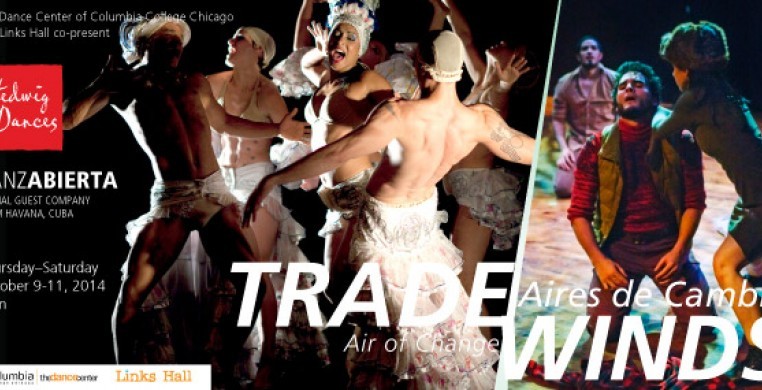“We can dance together; we are humans of the world!” says Cuba’s DanzAbierta resident choreographer Susana Pous, taking a break from her company’s joint rehearsal with Chicago’s Hedwig Dances. Dancing together is exactly what the two companies will be doing in their collaborative concert, “Trade Winds/Aires de Cambio,” (Air of Change) this Thursday, Friday and Saturday at 8 PM, October 9th-11th at the Dance Center of Columbia College.
Havana and Chicago, as different as hot and cold, come together in intersecting pieces, choreographed by Pous and Hedwig artistic director Jan Bartoszek. To sustain their long-distance collaboration, the two choreographers developed a working structure based on the relationship of cyclical time in two different cultures: north and south, temperate and tropical. Each choreographer developed separate pieces, Bartoszek’s “Trade Winds” and Pous’s “Aires de Cambio.”
The performance unfolds in a series of episodes following the course of the seasons, becoming a call and response between the two companies, Hedwig Dances primarily on one side of the stage and DanzAbierta on the other. Several scenes cross over and intersect. The hemispheric divide is represented with a line down the middle of the stage, and yet the dancers have awareness of each other.
The two companies share much in common--both DanzAbierta’s dancers and four of the six Hedwig dancers, who happen to be Cuban, all trained at the National School of Dance in Havana, and studied tecnica Cubana, ballet, and Afro-Cuban dance under the same teachers. Bartoszek observes that both Hedwig Dances and DanzAbierta emphasize moving with intentionality. “There’s a lot of weight given to the dancers’ attitude about dancing, how they gesture.”
Water provides another unifying feature of the collaboration. “It’s an image of growth and source of life in the work,” says Bartoszek. In the Spring section, water is poured over a dancer with a watering can. Water images recur throughout: a boat, a woman walking on water. “Water both connects and divides,” says Bartoszek.” Differences between the two cultures crystalized as the two companies developed their theme.
“Weather is a big difference,” says Pous. “In Havana, it’s very hot, always summer. The temperature affects the way people move, the way they touch and walk, and their relationships.”
“You discover that you have a completely different way of working and thinking,” says Guido Gali, DanzAbierta’s administrative director. “It opens your artistic perspective.” One thing Gali has found especially strange about work in the U.S. is the use of time. As an example, Gali sites the different pace of work in America, where people are paid for their time. Rigid schedules put everyone on a race to meet deadlines. “All life revolves around this!” In Cuba, where the arts are completely government-subsidized, “People have time to think,” and scheduling is more flexible and spontaneous. “We can rehearse for two hours or ten, and nobody complains...But then,” he laughs, “they can be lazy.” Pous and Gali agree, they have never had to put something together this quickly before. The experience has been both hair-raising and exhilarating.
In Cuba, artists enjoy high status. “Cuban artists are very deep,” he says. “In Cuba, there is Art, but there is not ‘entertainment.’”
“Dancing is vital in our country,” Pous says. “Cubans reflect a lot, think about the future. Dancing is a space of total freedom. Here, people are on edge.” That edge shows up in her choreography in the combined companies’ finale, where opposition and inversion, resistance and doubt evolve into partnerships of acceptance and trust. Edge is everywhere--in the relentless drive of percussive rhythms that compel the dancers in swift-flowing arcs around each other in rushing waves across the divide, like the wind that wraps the two hemispheres in a continuous exchange of ocean currents.
The commissioned score, which uses drums, trumpet, voice, keyboard and saxophone (played by Chicago musician John Brumback), is composed by Cuban musician Eme Alfonso, of the famed Cuban musical family dynasty.
Cinematographer Daniel Kullman and videographer Nadia Oussenko of Chicago, and Havana filmmaker Claudio Pairot have created video projections as a unifying element. Chicago and Havana are woven into the fabric of the dance, with seasonal landscape portraits of the two cities, relating to the movement on stage.
Communication has been the biggest challenge of the collaboration, Bartoszek says, not the least of which is the technology disconnect. “They don’t have cell phones, and email is spotty.” Translation is not always entirely reliable either. “Sometimes, I honestly think I understand, and then I realize--my God--I didn’t understand!”
As the two companies navigate their first-ever on-site joint rehearsal process, movement unites them in a universal language. From the looks of things in the rehearsal hall, Havana/Chicago relations are about to experience a lively surge. Let’s hope “Trade Winds/Aires de Cambio” inspires others to follow suit with future cross-cultural collaborations.
Lynn Colburn Shapiro, editor

